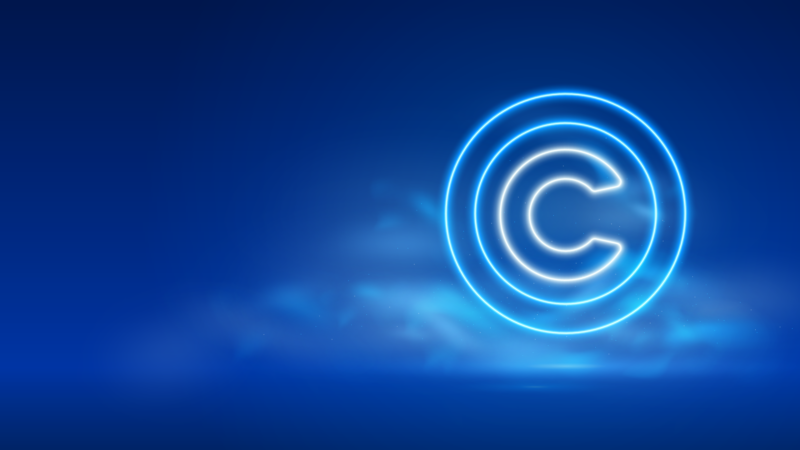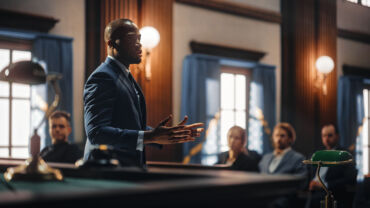Patent litigation spans market sectors and covers a broad range of practices. It is often costly and time-consuming, requiring substantial effort from plaintiffs to prove infringement claims in court.
However, many plaintiffs find the effort in court to be worth it. Protecting a patent from infringement can be vital to preserving a company’s earnings or market share.
Table of contents:
1. What are types of patent infringement?
2. Examples of patent infringement claims
How long do patent lawsuits take?
How much does it cost to litigate a patent?
What is the patent prosecution process like?
What you need to know about intellectual property
Patent litigation research tools
What is patent litigation?
Essentially, patent litigation is the process through which one party sues another for making allegedly unlawful claims upon their patented invention, without the patent holder’s permission.
It all starts with the patent, which is issued by a federal agency, the United States Patent and Trademark Office (USPTO). A patent holder has the right to seek to prevent others from making, offering, using, selling or importing the patented product, process, or service. A patent’s typical lifespan is 20 years from its filing date, though some only extend for 15 years.
There are three main types of patents. By far the most common type of patent (roughly 90% of those issued) is a utility patent, issued for the invention of, in the USPTO’s terms, “a new and useful process, machine, manufacture, or composition of matter, or a new and useful improvement thereof.” It grants protections for up to 20 years from the date of filing. The other two categories are design (a patent protecting any new, original, and/or ornamental design that’s part of or applied to an article of manufacture) for 15 years, and plant (a patent protecting any new or discovered asexually reproducing plant) for 20 years.
A patent has three main sections:
- Cover page (basics: descriptive summary of invention, inventor(s), date patent went into effect).
- Specifications (greater detail, including how to manufacture the patented invention, and “embodiments”—examples of invention in use).
- List of claims defining and limiting the patented invention’s core elements, much like how a surveyor will mark off the boundaries of a property (“metes and bounds”).
The federal government does not enforce patent rights, so patent litigation is a private matter. If a patent holder believes that another party has infringed upon their patent and chooses to litigate, they will file a civil lawsuit in a U.S. district court.
Patent infringement
In the U.S., patent infringement cases have waned and waxed over time. For example, in the economically turbulent late 19th Century and Great Depression era, patent protections were lax and infringement claims tended to fail in court. By contrast, since the 1980s, plaintiffs have had a more successful track record of patent litigation, with substantial jury awards in some cases.
A factor in this trend was the establishment of the Court of Appeals for the Federal Circuit in 1982. This clarified the substantial differences in patent cases between regional Circuit Courts of Appeal by Federal Circuit becoming the sole venue for patent litigation appeals.
In a boost for plaintiffs, Federal Circuit has ruled that anyone challenging the validity of a patent needs “clear and convincing” evidence to succeed. This is beyond the typical standard of proof in civil cases, in which an asserting party needs only to establish their case on the balance of probabilities.
What are types of patent infringement?
A patent infringement complaint falls typically into one of two categories. A lawsuit will allege direct or indirect infringement.
- Direct infringement: The defendant is alleged to have manufactured, used, sold (or offered to sell) and/or imported the plaintiff’s patented invention, method, or service without permission.
- Indirect infringement: The defendant has allegedly aided or enabled (“actively induced”) a third party to directly infringe upon the plaintiff’s patent. A subset of this is “contributory infringement,” in which the defendant has allegedly supplied other parties with a component of the patented invention.
Examples of patent infringement claims
In Litton Systems v. Honeywell (1990), plaintiff Litton had patented a means to place reflective coatings on mirrors inside ring laser gyroscopes (navigational devices used in commercial aircraft).
- The claim: Litton sued Honeywell for direct patent infringement, claiming that Honeywell had adopted Litton’s manufacturing process after having struggled to develop its own mirror technology. A jury awarded Litton $1.2 billion for lost past and future profits on navigation system sales.
In Krippelz v. Ford Motor Co. (2008), Jacob Krippelz had patented in 1989 a design for a small lamp mounted to a car’s sideview mirrors (a puddle lamp), and sent his patent to Ford, who wasn’t interested in licensing his invention. Krippelz sued Ford in 1998 upon discovering Ford installing similar puddle lamps on its new vehicles, kicking off more than a decade of litigation.
- The claim: Krippelz argued that Ford had prior knowledge of and willfully infringed upon his patent. Ford countered by arguing that Krippelz’s patent was invalid, as similar technology had been patented by Charles DuBois, a French inventor, in 1951. The jury was convinced by plaintiff expert witnesses that Krippelz’s patent was distinct from the DuBois patent and awarded damages to Krippelz. A district court judge more than doubled this to $55.6 million, claiming that Ford had acted recklessly by selling vehicles with puddle lamps even though Ford was aware of its potential infringement.
In 2012, Federal Circuit overturned the ruling, deciding that the Krippelz patent had indeed been made invalid by the prior DuBois patent.
Patent litigation
How long do patent lawsuits take?
U.S. patent litigation, from the initial plaintiff’s complaint to the end of an appeal, will take on average from three to five years. Chicago law firm Banner Witcoff, in an examination of patent litigation, noted that “pendencies in the trial courts vary widely” but that “a few courts scattered around the country run ‘rocket dockets’” for patent cases.
Thus, plaintiffs often aim to find a “rocket docket” for patent litigation. Because they can sue a patent infringer wherever their products are sold or distributed in the U.S., plaintiffs can shop around for a “fast” circuit to file in. If a patent litigation is managed well, a trial in such a docket could take under two years.
How much does it cost to litigate a patent?
Patent litigation typically carries substantial expenses. On average, the U.S. has the highest patent litigation costs globally, with only Hong Kong rivaling it, as per a 2019 Washington Law Review article. The authors estimated that the cost of litigating a patent in the U.S. will average about $3.5 million.
That said, there have been deflationary trends over the last decade. A 2015 survey by the American Intellectual Property Law Association found the median cost to litigate a single-patent infringement claim through trial was $5 million, for cases with more than $25 million at risk. But that median cost had fallen to $4 million by its 2019 survey. Further, between 2015 and 2019, the median cost fell 250%, to $1.5 million, for a patent infringement case with $1 million-$10 million at risk, as per the AIPLA.
Roughly half of the costs in a typical patent litigation are accrued by the end of discovery. For instance, each expert that a plaintiff hires to estimate patent violations and potential damages may charge over $100,000 in fees.
The remainder of costs are accrued in the trial process, including the expenses of hiring attorneys to staff the trial and for experts to testify. There are also sometimes inter partes review proceedings whose costs range from $300,000 to $500,000, including further consultant fees and filing expenses.
What is the patent prosecution process like?
Basically, the patent holder must prove to a judge and/or jury the likelihood that the defendant has infringed upon their patent.
In court, the defendant will often counter by asserting the patent claims in question are invalid. They may seek to prove the patented technology existed before the patentee’s filing (“prior art”) or argue that the patent’s language was insufficiently precise as to the protected invention.
To prove indirect infringement, the plaintiff must list specific actions the defendant undertook which led to another party committing a direct infringement. The plaintiff must also show that the defendant knew its activities would lead to this infringement, or that it was “willfully blind” as to the consequences of its actions.
Once the plaintiff has filed its claim, a typical patent litigation will proceed as follows (roughly in this order).
Discovery
Discovery is essential to a patent trial and can last from months to years. It includes:
- Exchange of internal business records between plaintiff and defendant. The court may be asked to compel the exchange if one party is resistant to sharing information.
- Interrogatories (written questions) exchanged between parties.
- Depositions (recorded, sworn, pretrial attorney questioning of witnesses and experts).
After discovery, there are typically requests for judgment without a trial (summary judgement), based on findings made during discovery, such as the validity of the infringed-upon patent.
Pre-trial motions
A month or so before the scheduled court date, parties will file pre-trial motions asking the judge to resolve issues relating to the conduct of the upcoming trial.
These motions can include:
- motions to strike expert testimony. Both plaintiff and defendant typically seek to preclude experts that the other side has hired to testify. They may argue that the expert’s testimony is inconsistent or irrelevant to the case.
- motions to bifurcate the case into separate trials. These motions can simplify the presentation of facts to the jury or speed up the process. Parties may ask to hold a trial on liability issues first, thus eliminating the need to have a subsequent trial to determine damages should no liability be found.
Markman hearing
Often before the trial begins, the judge will hold a Markman hearing to determine the meaning of specific terms in the patent. The judge will consider both intrinsic evidence—patent claims, prosecution history—and extrinsic evidence such as legal dictionaries and expert testimony.
This Markman hearing can be critical to the case, whose verdict may depend upon the agreed-upon meaning of a single clause in the patent claim.
Trial stage
A patent infringement trial is usually held before a jury, who will decide on factual issues of the case and determine damages should they find the defendant has infringed upon the patent.
As a typical jury is assumed to lack a technical comprehension of the patent in question, plaintiff attorneys usually start by explaining the patent’s workings. They will solicit testimony from fact witnesses, such the patent’s owner or inventor. They may put on the stand a key client or customer of the plaintiff to offer evidence to support the plaintiff’s claim for damages (such as a client who lost business due to the alleged infringement).
Plaintiff attorneys will offer expert testimony as to the purported infringement, and the amount of damages that should be levied against the defendant. The defendant will cross-examine these witnesses and introduce its own, aiming to challenge the validity of the patent.
Verdict and judgement
If the patent owner successfully proves infringement, they may ask the court for a number of actions:
- Monetary damages, estimated to compensate for a prospective lack of earnings due to the patent infringement.
- Injunctions, such as court orders barring the defendant from using the process or selling the product.
- Specified royalties in the event of potential future infringing activity.
Post-trial motions and appeals
Most cases have post-trial motions in which the losing party will ask the judge to reverse a jury decision because of errors in presentation or attorney misconduct, among other factors.
Losers in patent litigation often file an appeal. All appeals must be filed with Federal Circuit. After the filing, the case is docketed at Federal Circuit within 10 working days. The median time from docketing to Federal Circuit reaching a decision is roughly a year.
The Federal Circuit appeal typically consists of both parties making oral arguments before a three-judge panel. After this, the judges on the panel will vote. Unanimity isn’t required—two of three votes determine the verdict.
If a plaintiff or defendant fails on appeal, they have two chances left.
- En banc hearing. The losing party may file a petition for rehearing, either by the original appeal panel or the entire court. This is rare, and often only occurs because there was a substantive mistake in the original panel decision.
- Supreme Court review. The losing party may appeal to the U.S. Supreme Court by filing a petition for writ of certiorari within 90 days of Federal Circuit’s final judgement. While in the past it was rare for the Supreme Court to review a patent case, it’s become more prevalent of late. The Supreme Court reviewed 33 patent cases in the 2010s compared with eight in the 1990s.
Patent litigation case study
The 2000s-era court battles between Pfizer Inc. and Teva Pharmaceuticals/Sun Pharma are notable examples of successful patent litigation. The process was lengthy (taking nearly a decade before all issues were resolved) and complex, but Pfizer ultimately prevailed in defending its drug patents.
One case involved Pfizer’s acid reflex drug Protonix, which was approved for use in the US in 2002. In 2007 and 2008, respectively, Teva and Sun Pharma introduced generic versions of Protonix. By so doing, they pre-empted the 2011 expiry date of the patent on pantoprazole, Protonix’s active ingredient.
Teva and Sun took an “active risk” by jumping the gun on Pfizer’s patent’s expiry, hoping to prove in court that the patent should be declared invalid. Teva and Sun’s offerings posed a substantial threat to Pfizer’s earnings—Protonix sales reportedly fell by 80% upon the introduction of the two generics. In 2008, the year after Teva launched its generic, the once-blockbuster Protonix netted just $395 million.
Defendants claimed that the pantoprazole patent was invalid, arguing the patent was “obvious” due to multiple preceding factors, including an earlier, similar patent for omeprazole (the main ingredient for Prilosec) and articles detailing a similar drug manufacturing process that were published in medical journals in the 1960s and 1980s. The court ruled that the patent holder (Pfizer) had included enough exclusive manufacturing detail in its patent.
For the first time, a generic drugmaker had to pay damages for mimicking an existing drug still under patent protection. In 2010, a jury ordered the generics to pull their products from the market. Teva and Sun Pharma settled with Pfizer for $1.6 billion and $550 million, respectively.
What you need to know about intellectual property
Patents don’t stand alone. They’re one piece in an overarching category of intellectual property (IP), which often consists of a company’s most valuable assets. The other main categories of IP are trademarks, trade secrets, and copyrights.
There are distinct differences between IP categories. For example, patents protect a holder’s invention from others’ infringement. Trademarks, by contrast, protect names, logos, etc. that are used to distinguish goods and services in the marketplace.
In terms of copyright, the differences are starker. Patents protect “useful” inventions, while copyright protects artistic works. Patents are short-lived, whereas copyright protections currently extend for the life of the creator plus 70 years.
There can be some overlap in litigation. Patent and trademark protection may intertwine in some cases. For example, say a company develops a unique type of accounting software, patent-protects it, then trademarks it to distinguish the software in the marketplace. If this software is copied and/or marketed under a similar name by a competitor, the company may litigate for both patent and trademark infringement.
Patent litigation research tools
Patent litigation will often consume a substantial amount of a company’s time and rack up significant expenses. However, if a patent infringement threatens the company’s livelihood, litigation is a necessary act of competitive survival.
That said, there are ways to make the process more cost-efficient and less complex. The use of technology can improve a plaintiff’s research, speed up discovery, and enable attorneys to craft a more compelling and thorough argument in court. A service like Practical Law is an all-in-one tool with practicing attorney-editors offering expert guidance to help you through a patent litigation case.








